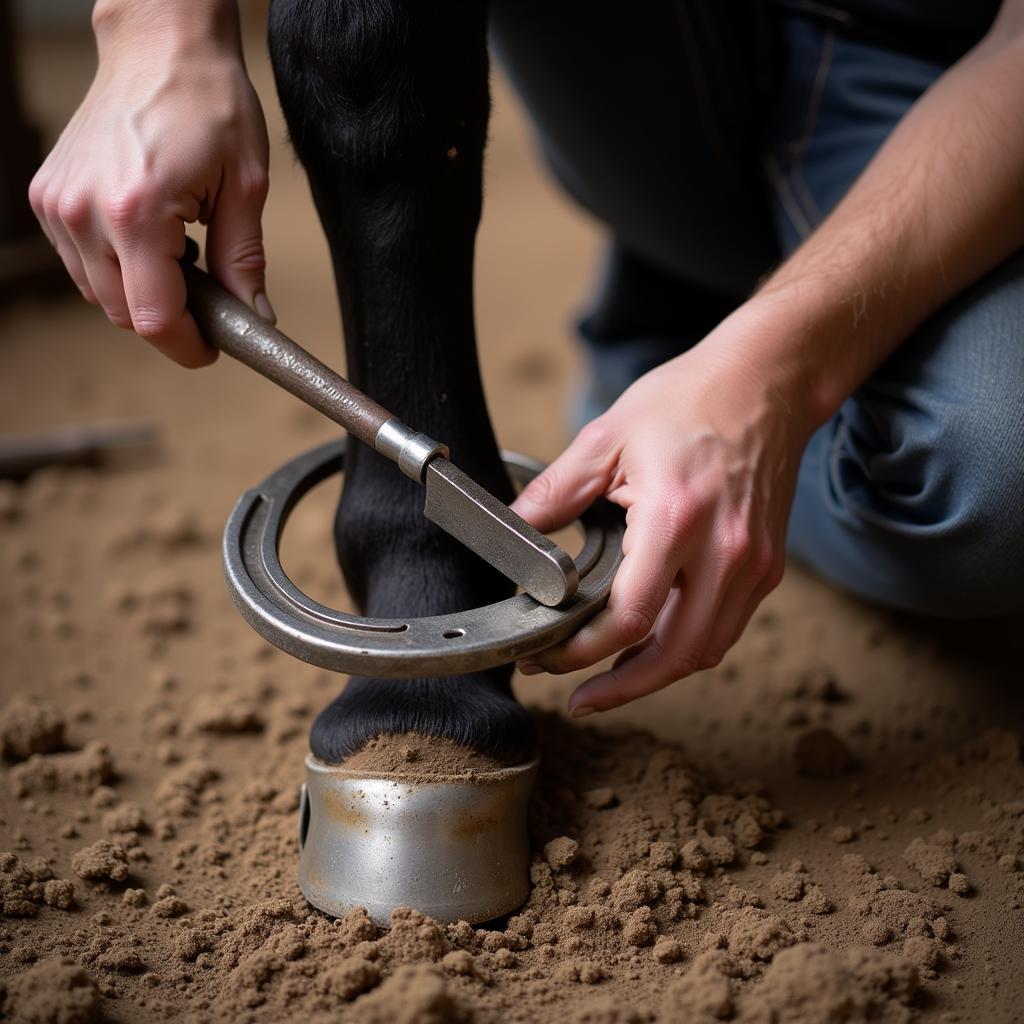Horse Leg Metal encompasses a variety of applications, from supportive shoes to decorative brass horse cart accents. Understanding the different types of metal used on and around horses is crucial for their well-being and can even enhance their performance. This article delves into the world of horse leg metal, exploring its various uses, benefits, and potential drawbacks.
The Purpose of Horse Leg Metal: Protection and Enhancement
Horses, like any athlete, can experience wear and tear on their legs. Horse leg metal, in the form of horseshoes, provides protection against excessive hoof wear, especially in demanding terrains. These shoes are typically made of steel or aluminum, offering durability and support. Furthermore, therapeutic shoes, incorporating specialized metal components, can address specific hoof problems or lameness issues. Beyond functionality, horse leg metal also plays a decorative role. From the intricate details of a horse racing trophy to the charming appeal of a cast iron horse bank antique, metal adds a touch of elegance and tradition to the equestrian world.
 Horseshoes on Horse Hooves
Horseshoes on Horse Hooves
Types of Horse Leg Metal and Their Applications
Different metals serve distinct purposes when it comes to horse leg care and equestrian accessories. Steel, renowned for its strength and affordability, is the most common material for horseshoes. Aluminum, being lighter, is often preferred for racing horses. Specialized alloys are utilized in therapeutic shoes to address specific conditions, offering customized support and promoting healing. Beyond horseshoes, various metals feature in equestrian equipment. Stainless steel bits, known for their durability and resistance to rust, are commonly used for horse control and communication.
What are the benefits of different metals used in horse leg care? Each metal possesses unique properties, influencing its suitability for specific applications. Steel’s robustness makes it ideal for everyday wear and tear, while aluminum’s lightness can enhance a horse’s speed and agility. Specialized alloys, with their tailored properties, provide targeted support and promote healing in therapeutic applications.
 Therapeutic Horseshoes
Therapeutic Horseshoes
Caring for Horse Leg Metal
Proper maintenance of horse leg metal is essential for both the horse’s comfort and the longevity of the equipment. Regular cleaning and inspection of horseshoes can prevent the buildup of dirt and debris, minimizing the risk of infection. Similarly, proper storage and care of metal equestrian accessories, such as bits and stirrups, can prevent rust and ensure their long-lasting functionality. Are there any potential risks associated with horse leg metal? While horse leg metal offers numerous benefits, it’s important to be aware of potential risks. Improperly fitted horseshoes can cause discomfort or even injury. Similarly, poorly maintained metal equipment can rust or break, posing a safety hazard. Regular farrier visits and meticulous equipment care are crucial to mitigate these risks. Perhaps you’re searching for a stylish accessory? Horse earings are a beautiful choice.
Choosing the Right Horse Leg Metal
Selecting the appropriate type of horse leg metal depends on several factors, including the horse’s activity level, hoof condition, and individual needs. Consulting with a qualified farrier is crucial to ensure the best possible fit and functionality for the horse. What are some common misconceptions about horse leg metal? One common misconception is that all horses require shoes. In reality, barefoot trimming can be a healthy alternative for some horses, depending on their environment and activity level. Another misconception is that horseshoes are painful. When applied correctly by a skilled farrier, horseshoes should not cause any discomfort.
Do you need a sturdy horse hitching post? We have a selection of durable and aesthetically pleasing options.
Conclusion: Prioritizing Horse Leg Health and Well-being
Horse leg metal plays a vital role in equine care, from protecting hooves to enhancing performance. Understanding the various types of metal, their applications, and proper maintenance practices is essential for ensuring horse comfort, safety, and overall well-being. Remember, consulting with a qualified farrier is crucial for making informed decisions about horse leg metal and providing the best possible care for your equine companion.
FAQ:
- How often should horseshoes be replaced?
- What are the signs of an improperly fitted horseshoe?
- What are the benefits of using aluminum horseshoes?
- How can I prevent rust on my metal equestrian equipment?
- What are the different types of therapeutic horseshoes available?
- How can I tell if my horse needs therapeutic shoes?
- What is the role of a farrier in horse leg care?
Common Scenarios and Questions:
-
Scenario: My horse keeps tripping. Could it be due to his shoes?
-
Question: How can I tell if my horse’s shoes are causing him discomfort?
-
Scenario: I’m considering switching my horse to aluminum shoes.
-
Question: What are the pros and cons of aluminum shoes compared to steel shoes?
-
Scenario: I noticed some rust on my horse’s bit.
-
Question: How can I remove the rust and prevent it from coming back?
Further Exploration:
Explore our articles on brass horse cart for more information on decorative equestrian metalwork.
Need assistance? Contact us at Phone: 0772127271, Email: [email protected] or visit us at QGM2+WX2, Vị Trung, Vị Thuỷ, Hậu Giang, Việt Nam. We have a 24/7 customer support team.